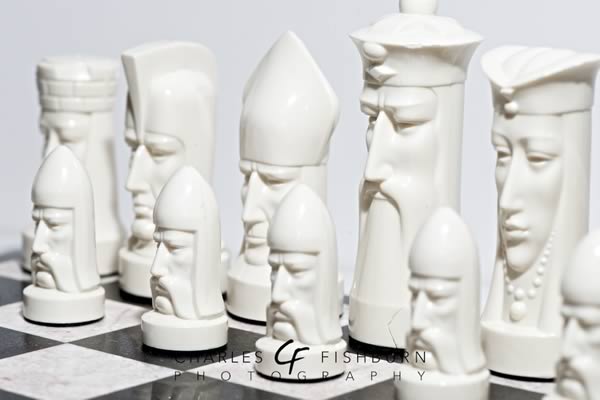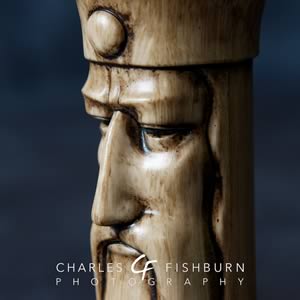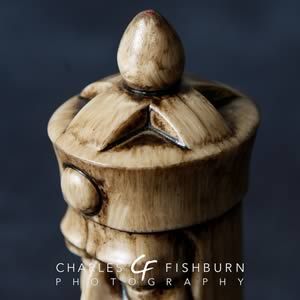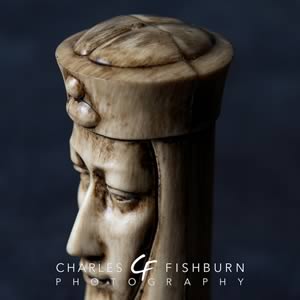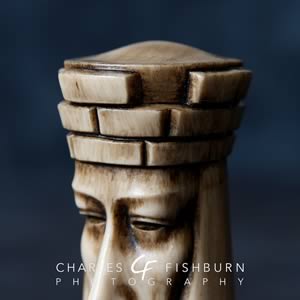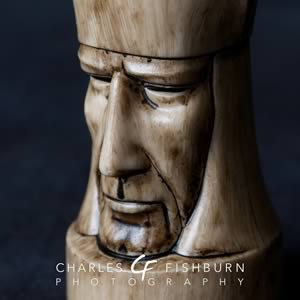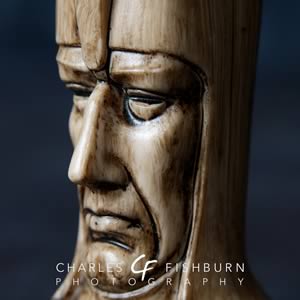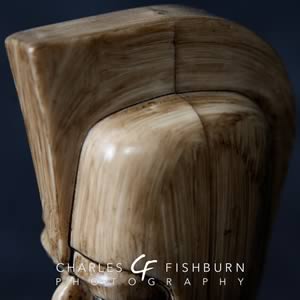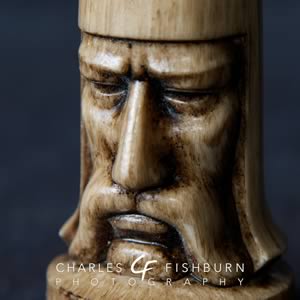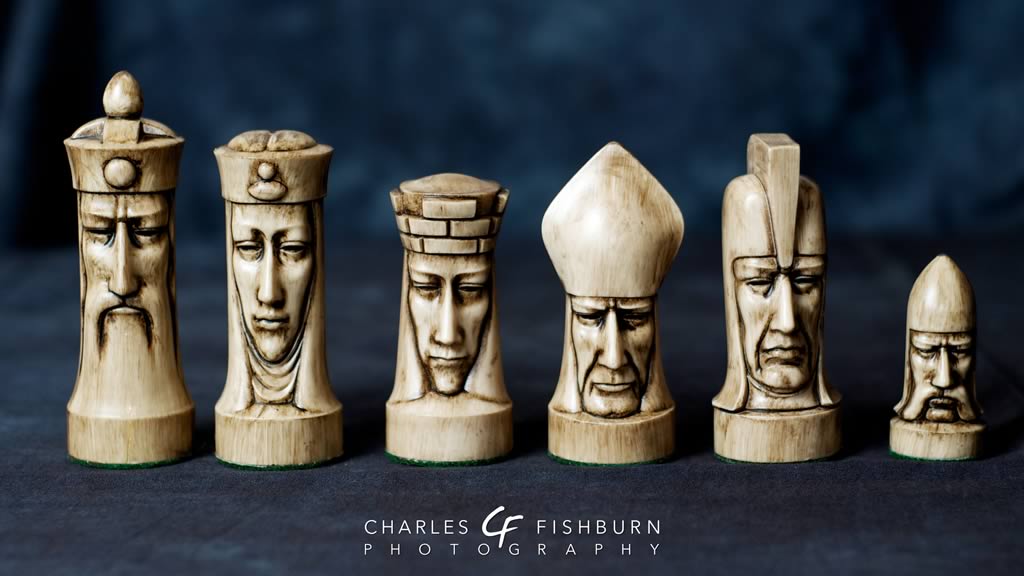
Updated 2016-04-25
"Gothic" Chess Set
by Peter Ganine
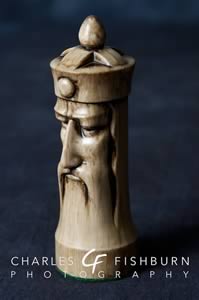
This distinctive-looking set is known as a Ganine "Gothic" Tournament Edition chess set, designed by sculptor Peter Ganine. Originally, I said that it was most likely designed in 1947 because that was the earliest date I ever saw on any of the sets or boxes. But the original date of design actually may go back to 1939. Dave C., a sharp-eyed fellow chess aficionado, brought to my attention a mention of this set back in the January 29, 1940 edition of Life magazine, which shows two photos of this set in its original ceramic construction. The caption under the photos says:
The modern American chess set, made in ceramics by Peter Ganine, is simple and dramatic. Each figure is easiliy distinguishable from the others. Ganine planned to reproduce the set, for popular sale, in bakelite, but the war prevented it. This set is worth $200.
Certainly the set was reproduced for popular sale somewhere near 1947. And, in fact, it was available, at least for some limited time, in Bakelite™. Another reader of this site, Jim W., passed along a link to the April 1949 issue of Popular Science which shows a single image of some of the pieces on a chess board. The text below reads:
Chess Set Made of Plastic
These smooth-lined, artistically formed chessmen should please chess fanciers. Created by Peter Ganine, scupltor and design consultant, they are made of red and black Bakelite™ phenolic plastic. The pieces are lightweight and said to be practically non-breakable. A carrying case comes with the set, which is nationally distributed by Zacho, of Los Angeles. In the luxury class, the chessmen retail for $75.
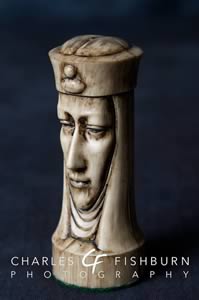
While the texture on the pieces of my particular set might lead you to believe that it might be carved or sculpted from some exotic material, I regret to inform you that it is simply a highly-molded plastic set. Back in the early- or mid-80s, I saw a ceramic chess set, mostly likely inspired by this set, on the coffee table of some family friends. I found that set to be peculiar, eccentric and rather unattractive. In my opinion, the ceramic set seems to be a rather poor imitation of the original Ganine design. But back then, I didn't really like the Ganine set either.
In the early 2000s, as I started noticing more the artistic details in various chess sets, I stumbled across the Ganine set once again. But this time, it seems I had gained an appreciation for the artistic eccentricity of the set and decided to try to add one to my collection. I acquired my Tournament Edition set in May 2005 through an eBay auction, and paid $136.38 (not including shipping and handling).
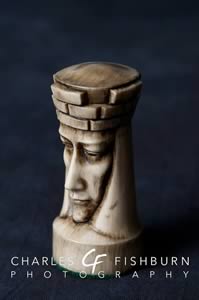
Peter Ganine designed another chess set known as the "Conqueror" chess set. Rather than a collection of heads, the set consists of tall, thin statuesque figures that, while distinctly different from the Gothic set, share a quality of eccentricity. At this point, I don't have any interest in acquiring that set, but if you like this "Gothic" chess set, you should look up the "Conqueror" chess set as well.
Details about the Ganine "Gothic" Chess Set
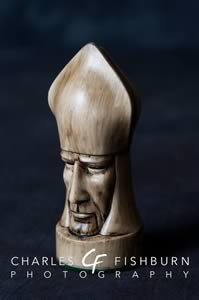
The "Gothic" set came in two versions: the Salon Edition and the Tournament Edition, the latter being much more rare. The Salon Edition was smaller – perhaps 75% the size of its big brother – and came with an unremarkable folding chessboard. The pieces were made of white (or ivory-colored) and black plastic and were quite glossy. The Tournament Edition was noticeably larger and feels big for a chess set, with the king standing about 4.5" tall. Initially, I reported here that the Tournament Edition did not come with a board because I had never seen any sold with an accompanying board. However, I have now seen a few sold with what seems to be an original board, albeit another unremarkable folding cardboard one.
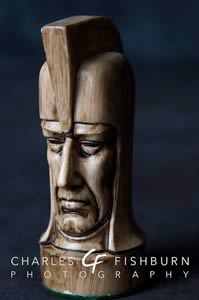
One thing I have noticed about the Tournament Edition is that it seems to have been available in a small variety of what I will call "finishes" (although I'm sure that's not quite the right word for it). Both the Salon and Tournament editions were available in a glossy black and equally glossy white or sometimes ivory. But you can see that my set has almost a grain-like texture or stain, along with some coloring to add depth and dimension to each piece. I have seen another Tournament Edition that looks like the plastic had some marbling characteristics to it. They're definitely unique in their own rights.
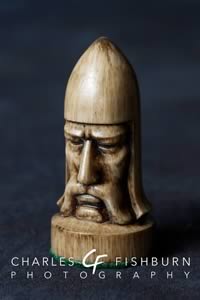
UPDATE: Thanks to Harold C. for pointing out that I neglected to mention relative sizes in terms of actual dimensions. He says the king in the Salon Edition stands about 3.5". Here's a list of the heights of the Tournament pieces:
| King | 4.5" |
| Queen | 3.75" |
| Rook | 3.25" |
| Bishop | 3.625" |
| Knight | 3.75" |
| Pawn | 2.375" |
The king's base is 1.5" in diameter. So for those of you who may have been wondering about actual sizes, there you have it. Thanks again, Harold, for bringing this to my attention!

